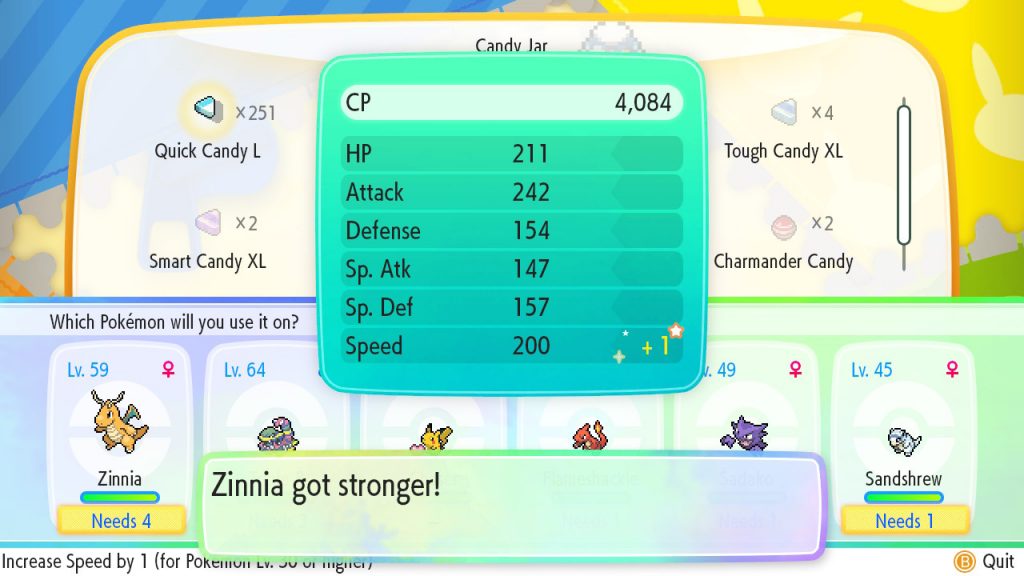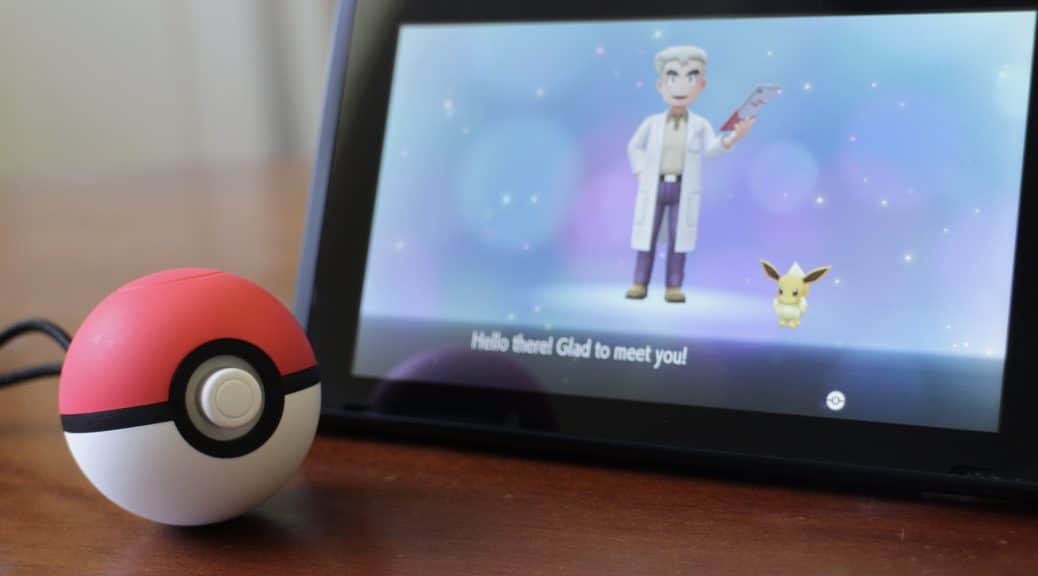Good, Fun Simplicity — Let’s Go Pikachu/Eevee and Poké Ball Plus Review
New Pokémon games are a great, yet different experience for all but the advanced battler. Both the games and the Poké Ball Plus are great complements to GO, too. Check out our extensive review on what’s different in Let’s Go, Pikachu! and Let’s Go, Eevee!
Stat levelling made (too) simple

Another key change more advanced players will notice is the removal of effort values (EVs, or officially, “base stats”), removing a rather complex system for calculating a Pokémon’s stats. Effort values have instead been replaced by a system internally referred in the game files as “awakening” values.
Effort values, as used in every Pokémon role-playing game since Pokémon Ruby and Pokémon Sapphire, are points typically accumulated in conjunction with Exp. Points when defeating a Pokémon. A Pokémon would receive at least one point depending on the Pokémon that was defeated, for a maximum of 252 effort points for any particular stat. Furthermore, every four points would add +1 to that stat. The total number a Pokémon’s effort values could total was 510, so at best, a Pokémon could have two stats maxed out by 63, and one stat maxed out by 1 stat point. With the changes to Exp. Share since Pokémon X and Pokémon Y, the entire party would receive the effort points earned from a Pokémon’s defeat.
If it all sounds confusing to you, it’s probably why Game Freak opted to eschew them for the Let’s Go titles.
Awakening values are instead simply bonus stat points on top of a Pokémon’s existing stats. Wild encounters do not award awakening points — they are instead awarded via level up (what stat gets elevated for a particular level up is determined by the species of Pokémon being levelled) or by giving Candy to a Pokémon. Ignoring the Rare Candy, there are two types of Candies in the games: Pokémon-specific Candies and Candies for each stat. Pokémon-specific Candies elevate each stat by one point for the particular Pokémon or its evolution line. Stat-specific Candies elevate a particular stat by one point, as per their name. Stat-specific Candies come in regular, L, and XL variations — as the Pokémon’s awakening values increase, you’ll need to feed the Pokémon more Candies of that particular size. For example, after a Pokémon is fed enough of a regular-sized Candy, it’ll start requiring two of that Candy. You’ll be able to get around this by feeding it an L or XL Candy (that is, until you’ve fed it enough of those), but L Candies will require the Pokémon to be Level 30 or higher, and for XL, 60 or higher.
A Pokémon can accumulate up to 200 stat points for each stat, with no other limit on how many stat points they can accumulate in total, so with enough Candies, you could elevate every stat to 200 points each for your Pokémon.
This system seems pretty great if you’re just playing the game for fun or battling against friends who don’t care so much about stats. For those who battle competitively though, stats boosted this way could turn battles into a slog, which we’ll detail next.
Simpler battle mechanics work for casual play
Battles in Let’s Go, Pikachu! and Let’s Go, Eevee! are against other Pokémon Trainers, and bar a couple of features being removed, work much like they do in traditional Pokémon games. We get the surprising omissions of Abilities and Hold Items, for one. On the other hand, Mega Evolutions come to Kanto for the first time!
Abilities and Hold Items are series staples that the more competitive of players take for granted, so their removal in Let’s Go leaves some of them disappointed. For the uninitiated: Abilities are a mechanic that provides effects in-battle for a Pokémon (and for some abilities, outside of battle) and were introduced in the third-generation games. Abilities can kick in depending on certain conditions, such as when a Pokémon is hit by certain types of attacks. Hold items are items that you can attach to a Pokémon to also provide some other kinds of effects, and much like Abilities, are triggered when some conditions are met.

Their omission is peculiar, particularly with how much it changes the viability of using and battling various Pokémon in the games. Credit where it’s due: it does simplify battles significantly, as there’s less factors to consider between you and your opponent. This can be a double-edged sword. Take the instance where a computer-controlled opponents puts your Pokémon to sleep: a classic Kanto strategy. Without a held Lum Berry to cure your Pokémon of status ailments, you’ll be left with no defenses outside of using an item, move, or hoping for luck — and when battling against a human, you won’t have items.
You won’t be able to rely on a Koffing or Weezing having Levitate to nullify those Ground-type moves, or a Rhydon with Lightning Rod to nullify Electric-type moves. Dragonair can’t have its stats boosted with an Evolite nor shake paralysis with Shed Skin. At the same time, you won’t need to worry about other Trainers having those Abilities, either. You may find, however, that not needing to factor in for Hold Items or Abilities may actually make battles boring, particularly if you’re a seasoned battler.
It’s unclear as to why Abilities and Hold Items have been removed. Did Game Freak feel that players coming from Pokémon GO would find them too much to work with? Was the set up considered too confusing and they had no solution to make it easier? Their removal ends up feeling really arbitrary, considering what’s still in the games. The Let’s Go titles still have advanced mechanics like Natures, which are personalities randomly assigned to each Pokémon you encounter that give Pokémon a positive boost in one stat, and a negative in another. These aren’t featured in GO in any capacity, and become a variable that will still affect anyone who wants to enter Pokémon into battles.
What’s also particularly confusing is the inclusion of Mega Evolutions. This is a mechanic that allows Pokémon to “evolve” in-battle, with its stats adjusted to make it almost as powerful as a Legendary Pokémon (like Mewtwo, who can also Mega-Evolve). The mechanic behind this has been made a lot simpler with the removal of Hold Items, as you simply need to have the requisite Mega Stone in your Bag. You’ll still need a Key Stone, which you’ll obtain late in the story, and even then you won’t be able to get most Mega Stones until you’ve finished the story. Without Abilities, though, some Mega Evolutions such as Charizard end up being less useful, what with its inability to change the weather upon Mega-Evolving. Perhaps Mega Evolution has been included simply because the gist of it becomes really simple at the end of the day. It makes Pokémon much more powerful than they would normally be, and unchecked, could turn the tide for casual battles. And for Pokémon you bring from GO, Mega Evolution is a cool little opportunity to see how amazing they could become in battle.
The ability to elevate Pokémon stats to an additional 200 points, on top of their regular stats, may also be a game-breaker. A Pokémon several levels below could easily outmatch a much higher-leveled Pokémon when given enough Candy. This isn’t so much a problem with battles in-game. If you’re using the multiplayer battle modes and select “No Restrictions”, particularly when your opponent has boosted their Pokémon’s awakening points to their maximum, battles can end up taking forever to finish. Since it’s feasible for any Pokémon to have their stats maxed out, players may encounter challenges with other players’ Pokémon having maximized Defense or Special Defense, making those Pokémon potentially harder or take more time to defeat than normal. Battling with “Normal Rules” will remove awakening points, which levels the playing field but means your battles will be solely dependent on your Pokémon’s individual strengths (IVs, if you’re so inclined) and the moves your Pokémon have, since effort values aren’t here this time. Awakening values aren’t a bad idea and are a lot simpler to work with, but they would need significant changes before we should see them in the traditional competitive battling scene.
And that’s probably how it’s meant to be. The Pokémon World Championships in 2019 will continue to be played using Pokémon Ultra Sun and Pokémon Ultra Moon, so it’s pretty clear from the get-go that Let’s Go isn’t designed for these kinds of battles, what with the removal of Abilities and Hold Items. Whether the changes made in these games will have any bearing on the eighth-generation Pokémon games remain to be seen, but if you ever wonder what things would be like without these battle features, the Let’s Go titles give you a taste of that. It tastes basic.
An overall thought on the mechanics
Whether any flaws in the mechanics or balancing issues actually matter remains subjective — it’s all dependent on the kind of Pokémon player you are. For some, throwing Poké Balls directly at a Pokémon without worrying about it fainting half your team is a boon. Being able to encounter them running around in the wild really makes the world seem alive. If you’re here for a casual stroll through a Pokémon game, catching ’em all and taking names, then the simplification of battles and Pokémon stats will not matter so much to you at all.
If on the other hand, you’re a traditional player, you might find the changes hard to swallow, and the game rather easy. Perhaps you’ll be excited to use strategies that the old guard had to in the first-generation games — consider it a personal challenge. Perhaps you’ll never buy the game.
